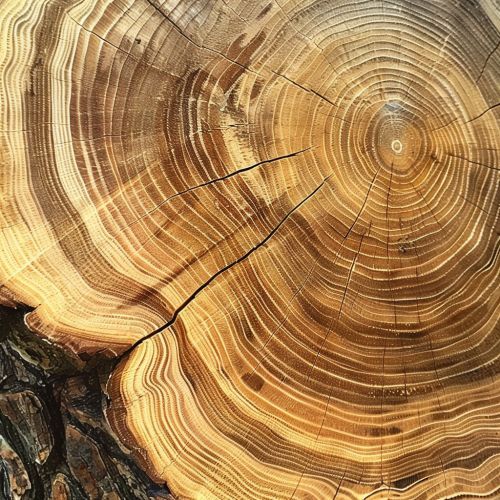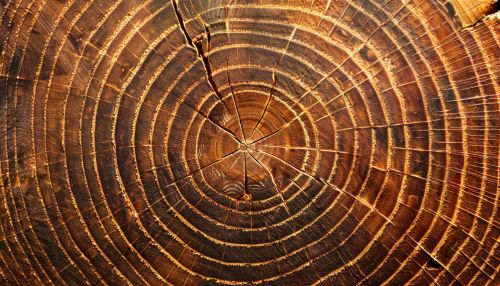Wood
Introduction
Wood is a porous and fibrous structural tissue found in the stems and roots of trees and other woody plants. It is an organic material – a natural composite of cellulose fibers that are strong in tension and embedded in a matrix of lignin that resists compression. Wood is sometimes defined as only the secondary xylem in the stems of trees, or it is defined more broadly to include the same type of tissue elsewhere such as in the roots of trees or shrubs. In a living tree it performs a support function, enabling woody plants to grow large or to stand up by themselves. It also conveys water and nutrients between the leaves, other growing tissues, and the roots. Wood may also refer to other plant materials with comparable properties, and to material engineered from wood, or wood chips or fiber.


Structure and Growth
Wood is composed of cells, and, as in all plant cells, there is a cell wall, which is what gives the wood its structural strength. The cell wall is composed of three layers: the primary wall, the secondary wall, and the middle lamella. The primary wall is the first layer of the cell wall that is formed. It is flexible and allows for cell growth. The secondary wall is formed inside the primary wall after the cell is fully grown. It is composed of several layers, and it gives the cell most of its structural support. The middle lamella is the outermost layer of the cell wall. It is composed of pectin and helps to bind cells together.
Wood is formed in the plant through the process of photosynthesis. Photosynthesis is the process by which plants convert light energy, usually from the sun, into chemical energy in the form of glucose. This glucose is then used to form cellulose, which is the main component of the cell wall. The process of photosynthesis takes place in the leaves of the plant, and the glucose is transported down to the rest of the plant, including the roots, through the phloem. The glucose is then used to form cellulose, which is the main component of the cell wall.
The growth of wood in a tree is a complex process. The tree's growth begins with the division of cells in the cambium, a layer of tissue in the tree that produces new cells. These new cells then grow and differentiate into the various types of cells found in wood, including parenchyma, fibers, and vessels. The growth of these cells is what ultimately forms the wood of the tree.
Types of Wood
There are many different types of wood, each with its own unique properties and uses. Some of the most common types of wood include hardwoods and softwoods. Hardwoods are typically denser and stronger than softwoods, making them ideal for uses that require strength and durability, such as furniture and flooring. Softwoods, on the other hand, are typically less dense and easier to work with, making them ideal for uses such as paper production and construction.
Hardwoods are derived from angiosperm trees, which are typically broad-leaved trees. Some examples of hardwoods include oak, maple, and walnut. Softwoods are derived from gymnosperm trees, which are typically coniferous trees. Some examples of softwoods include pine, spruce, and fir.
In addition to hardwoods and softwoods, there are also engineered woods. Engineered woods are man-made products that are made from wood, but have been processed in some way to enhance their properties. Some examples of engineered woods include plywood, particleboard, and fiberboard.
Uses of Wood
Wood has been used by humans for thousands of years for a variety of purposes. Today, it is used in a wide range of applications, from construction and furniture making, to paper production and fuel.
In construction, wood is used for a variety of purposes, including framing, flooring, and roofing. It is also used in the production of doors and windows. In furniture making, wood is used to create a wide range of items, from tables and chairs, to cabinets and beds.
Wood is also used in the production of paper. The wood is first pulped, and then it is processed to remove the lignin, which is the substance that gives wood its strength. The remaining cellulose fibers are then used to create paper.
In addition to these uses, wood is also used as a fuel. Wood can be burned to produce heat, and it is also used in the production of charcoal, which is used for cooking and heating.
Environmental Impact
The use of wood has a significant impact on the environment. On the one hand, the harvesting of wood can lead to deforestation, which can have a number of negative environmental impacts, including loss of biodiversity, disruption of water cycles, and contribution to climate change. On the other hand, wood is a renewable resource, and if managed sustainably, the harvesting of wood can actually have positive environmental impacts.
Sustainable forestry practices can help to ensure that the harvesting of wood does not lead to deforestation. These practices include selective cutting, where only certain trees are cut down, and reforestation, where trees are planted to replace those that have been cut down.
In addition to sustainable forestry practices, the use of engineered woods can also help to reduce the environmental impact of wood use. Engineered woods are made from wood waste and other byproducts of the wood processing industry, which can help to reduce the amount of wood that needs to be harvested.
